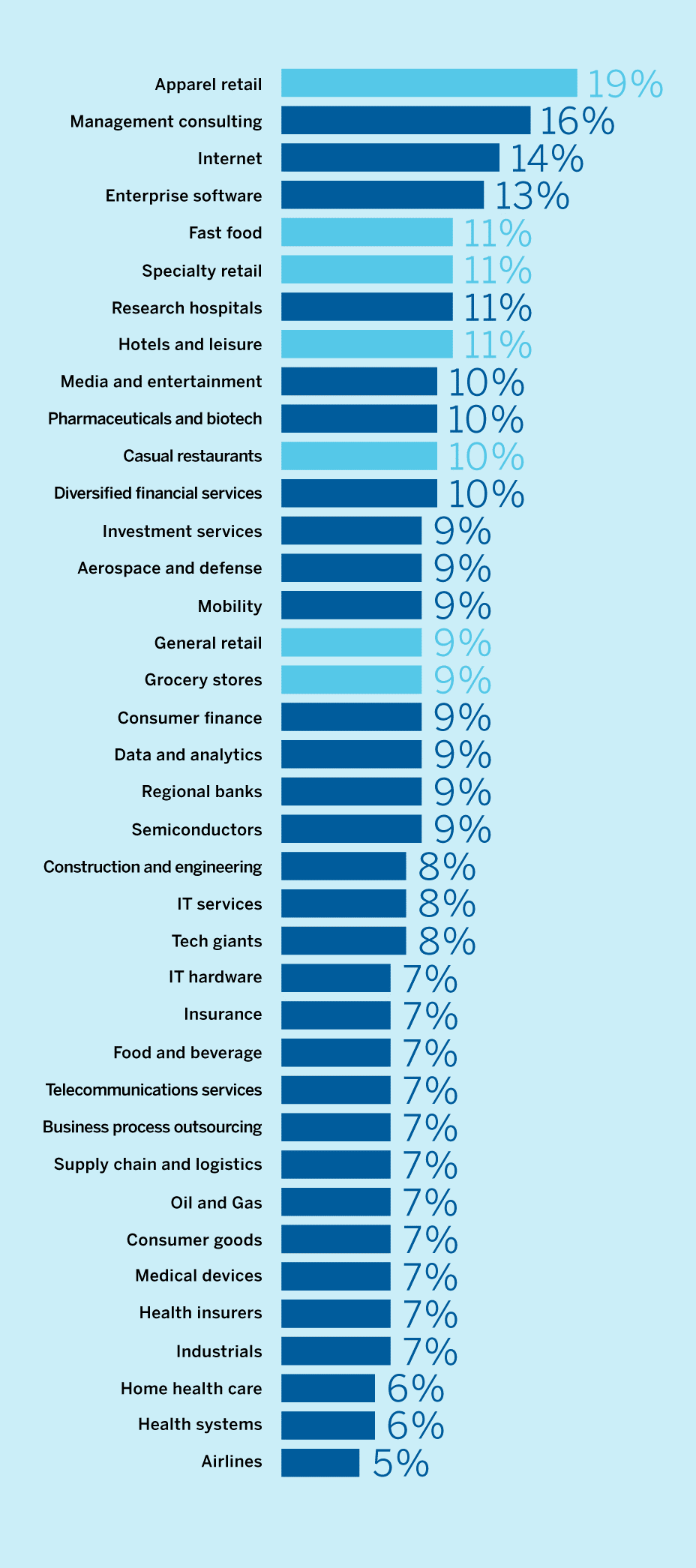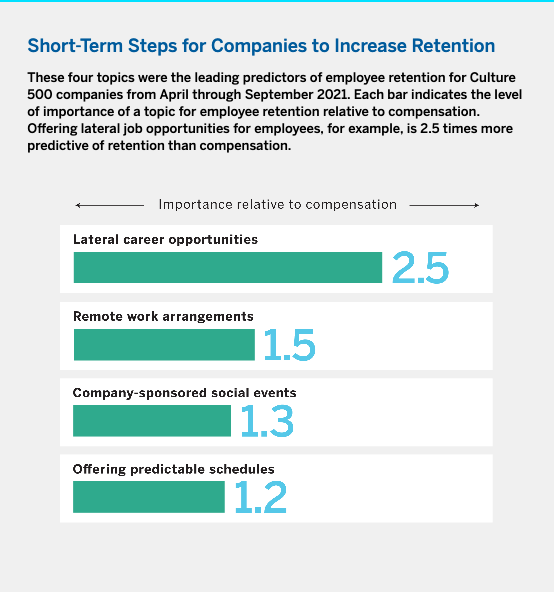The 5 Reasons People Are Quitting Their Jobs During The Great Resignation
February 3, 2022
Future of Work
Sustainability
Wellbeing
Over the past six months, thought leaders and CEOs alike have authored countless pieces on the world of work – and the so-called Great Resignation. Leaders across the world are struggling to understand what factors are driving the mass exodus as millions of workers leave their jobs, leading to staffing shortages and a talent retention crisis. Research suggests performance measurements, wellbeing, and management may all be factors. There have been few conclusive answers for why so many people are quitting during The Great Resignation. But the quitting contagion is a real phenomenon – and it’s been happening at companies regardless of their management styles or their low wages. "We're very social creatures, and we tend to take cues from the people around us," Mary-Clare Race, organizational psychologist and chief innovation officer at the HR consulting company LHH, told INC. So why, then, are people leaving their jobs? Are higher wages all that matter Or do workers want jobs that better align with their values? A recent MIT Sloan Management Review has some answers, based on data drawn from the analysis of 34 million online employee profiles of U.S. workers who left their jobs for any reason—quitting, retiring, or due to a layoff) between April and September 2021. Here’s why people are walking away from their jobs – and how managers and leaders can improve the situation.
The Great Resignation doesn’t just revolve around pay
The global pandemic was bound to impact worker/employer relations. And it has: Between April and September 2021, industries saw higher than usual levels of worker resignations, and some industries—such as the apparel retail industry—have been noticeably harder hit by this so-called Great Resignation. There was nearly three times the attrition in apparel retail as in the airline industry, for example.
The industry average attrition rate in the Great Resignation, as shown in this graphic from MIT Sloan Management Review.
Both industrial and office sectors have been affected equally by the Great Resignation. Some of the industries showing the most attrition—apparel retail, fast food—account for a high percentage of industrial workers, while another hard-hit industry—management consulting—employs the largest percentage of office professionals of any Culture 500 industry.
What we’ve seen is a massive spike in resignations and rates of attrition across industries. The numbers are staggering, but the key questions are why, and what can management do to stop this talent drain.
According to the report, although there has been much media attention put on employees’ dissatisfaction with their wages, compensation “ranks 16th among all topics in terms of predicting employee turnover. This result is consistent with a large body of evidence that pay has only a moderate impact on employee turnover.”
Instead, workers are frustrated by broader issues, relating to the culture and to the decision-making or priorities of management. Here are the top 5 indicators of high turnover in an organization.
This, the report states, is “by far” the strongest predictor of attrition—up to ten times higher than dissatisfaction with pay. According to the report, “The leading elements contributing to toxic cultures include failure to promote diversity, equity, and inclusion; workers feeling disrespected; and unethical behavior.”
Employees are less inclined to stay through rough patches or even through good times if they feel low levels of job security. A history or restructurings or layoffs when business is not going well does not build assurance in employees that they are safe in their jobs, which, no surprise, leads them to look elsewhere.
This one may take you by surprise. Isn’t innovation a good thing? Don’t employees want to be ever-learning, ever-curious, ever-innovating? It might be puzzling, but according to the report’s authors, “we found that the more positively employees talked about innovation at their company, the more likely they were to quit. The attrition rates of the three most innovative Culture 500 companies — Nvidia, Tesla, and SpaceX — are three standard deviations higher than those in their respective industries.”
What it comes down to is, despite innovation being exciting, it’s also quite stressful, and can knock work/life balance off to the point of a burnout.
The report is clear: “Employees are more likely to leave companies that fail to distinguish between high performers and laggards when it comes to recognition and rewards. Companies that fail to recognize and reward strong performers have higher rates of attrition, and the same is true for employers that tolerate underperformance.”
The emphasis here is not on monetary compensation, but rather simple recognition. It is a lack or undeserved presentation leads to resentment, which leads to resignation.
Companies had a lot of choices to make when it came to responding to the COVID-19 pandemic. Companies that failed to prioritize their employee’s health and well-being saw higher rates of attrition.
Both industrial and office sectors have been affected equally by the Great Resignation. Some of the industries showing the most attrition—apparel retail, fast food—account for a high percentage of industrial workers, while another hard-hit industry—management consulting—employs the largest percentage of office professionals of any Culture 500 industry.
What we’ve seen is a massive spike in resignations and rates of attrition across industries. The numbers are staggering, but the key questions are why, and what can management do to stop this talent drain.
Top 5 reasons people are walking quitting their jobs
Hint: It’s not the money.
According to the report, although there has been much media attention put on employees’ dissatisfaction with their wages, compensation “ranks 16th among all topics in terms of predicting employee turnover. This result is consistent with a large body of evidence that pay has only a moderate impact on employee turnover.”
Instead, workers are frustrated by broader issues, relating to the culture and to the decision-making or priorities of management. Here are the top 5 indicators of high turnover in an organization.
#1. Toxic corporate culture.
This, the report states, is “by far” the strongest predictor of attrition—up to ten times higher than dissatisfaction with pay. According to the report, “The leading elements contributing to toxic cultures include failure to promote diversity, equity, and inclusion; workers feeling disrespected; and unethical behavior.”
#2. Job insecurity and reorganization.
Employees are less inclined to stay through rough patches or even through good times if they feel low levels of job security. A history or restructurings or layoffs when business is not going well does not build assurance in employees that they are safe in their jobs, which, no surprise, leads them to look elsewhere.
#3. High levels of innovation.
This one may take you by surprise. Isn’t innovation a good thing? Don’t employees want to be ever-learning, ever-curious, ever-innovating? It might be puzzling, but according to the report’s authors, “we found that the more positively employees talked about innovation at their company, the more likely they were to quit. The attrition rates of the three most innovative Culture 500 companies — Nvidia, Tesla, and SpaceX — are three standard deviations higher than those in their respective industries.”
What it comes down to is, despite innovation being exciting, it’s also quite stressful, and can knock work/life balance off to the point of a burnout.
#4. Failure to recognize performance.
The report is clear: “Employees are more likely to leave companies that fail to distinguish between high performers and laggards when it comes to recognition and rewards. Companies that fail to recognize and reward strong performers have higher rates of attrition, and the same is true for employers that tolerate underperformance.”
The emphasis here is not on monetary compensation, but rather simple recognition. It is a lack or undeserved presentation leads to resentment, which leads to resignation.
#5. Poor response to COVID-19
Companies had a lot of choices to make when it came to responding to the COVID-19 pandemic. Companies that failed to prioritize their employee’s health and well-being saw higher rates of attrition.

So, what can companies do to slow The Great Resignation?
With 41% of employees considering changing jobs this year, what can leaders and businesses do to keep their talent? As Alain Dehaze concludes, “When employees feel heard, understood and cared for, they work harder, take more risks, and help others succeed. This in turn improves talent retention.”
The MIT Sloan Review offers some short-term steps organizations can take to slow down the high rates of resignation seen over the last period. Many of the reasons identified as indicators of a Great Resignation are not quick to fixes. They speak to engrained, deep-seeded cultural issues that can be very disruptive if impossible to turn around quickly.
Here’s where organizations should prioritize their focus in trying to stall and reverse the steady flow of resignations across the workforce:
Leadership is not for everyone. Employees who are technically brilliant in their job do not necessarily want to climb the corporate ladder or take on additional work or responsibilities—but they do desire recognition and growth, and the chance to try something new. Says the report: “Lateral career opportunities are 12 times more predictive of employee retention than promotions.”
Upskilling opportunities can also make a big difference for many employees re-evaluating career moves. Our report shows that only 37% of non-managers believe their company is effectively investing in developing their skills. "The demand for career advancement is very high, and organizations need to provide those opportunities," Race said. "If they don't, the individual will go and find it elsewhere."
Employees need to feel connected with their team members, and company-organized social events—happy hours, team-building exercises, employee and family dinners, and other activities keep a healthy corporate culture, so naturally they are connected to higher rates of employee satisfaction and retention.
Media coverage of The Great Resignation stresses the point of remote work the most, but according to the report, options to work remotely had about the same minimal impact on turnover predictions as did compensation. Still, says the report, “when employees discussed remote work options in more positive terms, they were less likely to quit.”
Industrial workers indicated they are less likely to quit when they can predict their schedule. In fact, employees with a predictable schedule are six times more likely to remain in their jobs than those who do not. This did not appear as a predictor in office workers. When industrial employees describe their schedules as predictable, they are less likely to quit. (A predictable schedule has no predictive power for office employees.)
The last couple years have shaken up a lot in terms of how we live and work. It was bound to bring to the surface issues and dissatisfaction at work, both those resulting from the pandemic and those that existed prior to 2020. It’s time to listen to feedback, rethink old ways, and find paths to ensure the relationship of employee/employer is strengthened as a result.
The MIT Sloan Review offers some short-term steps organizations can take to slow down the high rates of resignation seen over the last period. Many of the reasons identified as indicators of a Great Resignation are not quick to fixes. They speak to engrained, deep-seeded cultural issues that can be very disruptive if impossible to turn around quickly.
Here’s where organizations should prioritize their focus in trying to stall and reverse the steady flow of resignations across the workforce:
Provide opportunities for lateral job moves.
Leadership is not for everyone. Employees who are technically brilliant in their job do not necessarily want to climb the corporate ladder or take on additional work or responsibilities—but they do desire recognition and growth, and the chance to try something new. Says the report: “Lateral career opportunities are 12 times more predictive of employee retention than promotions.”
Upskilling opportunities can also make a big difference for many employees re-evaluating career moves. Our report shows that only 37% of non-managers believe their company is effectively investing in developing their skills. "The demand for career advancement is very high, and organizations need to provide those opportunities," Race said. "If they don't, the individual will go and find it elsewhere."
Sponsor corporate social events.
Employees need to feel connected with their team members, and company-organized social events—happy hours, team-building exercises, employee and family dinners, and other activities keep a healthy corporate culture, so naturally they are connected to higher rates of employee satisfaction and retention.
Offer remote work options.
Media coverage of The Great Resignation stresses the point of remote work the most, but according to the report, options to work remotely had about the same minimal impact on turnover predictions as did compensation. Still, says the report, “when employees discussed remote work options in more positive terms, they were less likely to quit.”
Make schedules more predictable for front-line employees.
Industrial workers indicated they are less likely to quit when they can predict their schedule. In fact, employees with a predictable schedule are six times more likely to remain in their jobs than those who do not. This did not appear as a predictor in office workers. When industrial employees describe their schedules as predictable, they are less likely to quit. (A predictable schedule has no predictive power for office employees.)
Looking ahead
The last couple years have shaken up a lot in terms of how we live and work. It was bound to bring to the surface issues and dissatisfaction at work, both those resulting from the pandemic and those that existed prior to 2020. It’s time to listen to feedback, rethink old ways, and find paths to ensure the relationship of employee/employer is strengthened as a result.



